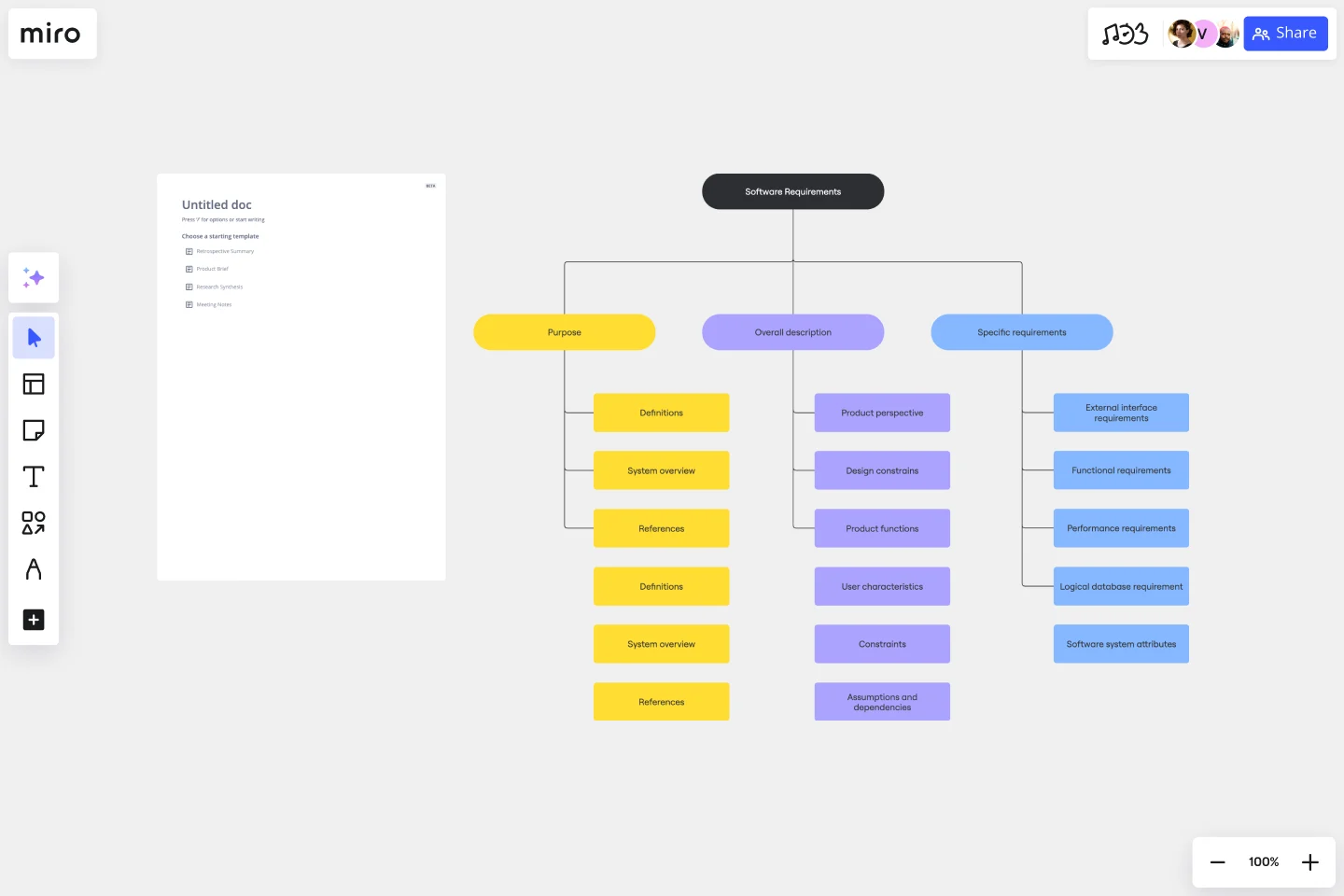Software Requirements Document
Streamline your software project management with Miro's software requirements document template.
About the Software Requirements Document Template
The software requirements document template provides an elevated project management experience. It simplifies the often complex process of documenting software requirements by offering teams a collaborative space to efficiently define, organize, and communicate project specifications. This template allows project teams to work together seamlessly and improve their productivity.
What's the software requirements document template?
The software requirements template is a complete solution for software teams. It includes key areas serving distinct objectives:
Purpose: Clearly define the goals and objectives of your software project, ensuring everyone is aligned with the overarching mission.
Overall description: Paint a detailed picture of the project by outlining its scope, boundaries, and the general context in which the software will operate.
Specific requirements: Drill down into the nitty-gritty details. Specify functional and non-functional requirements, providing a roadmap for development without room for ambiguity.
How to use the software requirements document template
Effortless editing: Customize the template to suit your project needs effortlessly. Make changes with just a few clicks, ensuring your document reflects the most up-to-date information.
Automated flowchart expansion: Expand your project's flowchart dynamically. Add new elements or connect existing ones, all with a single click with automated diagramming features.
Contextual artifacts: Enhance your document by incorporating artifacts directly onto the Miro board. Whether it's wireframes, mockups, or charts, add visual elements to provide additional context to your requirements.
Why should you use a software requirements document template?
Clarity: Ensure a shared understanding of project requirements, minimizing misunderstandings and fostering team cohesion.
Efficiency: Streamline the documentation process, saving time and resources that can be better allocated to actual project development.
Collaboration: Foster a collaborative environment with real-time editing and commenting features, promoting effective teamwork.
Visualization: Leverage Miro's visual interface to create a clear and engaging representation of software requirements, aiding comprehension.
Documentation: Generate a comprehensive document that is a valuable reference point throughout the project's lifecycle, from planning to execution.
Discover work breakdown structure examples for your IT projects and create the next big thing.
Can I tailor the template to my specific project requirements?
Absolutely! The template template is fully customizable, allowing you to adapt it to the unique needs of your software project.
How does the template handle changes and updates?
Updates are a breeze – edit easily, and your document will always reflect the latest project information.
Can I collaborate with team members in real time?
Yes, Miro's collaborative features enable real-time interaction, making teamwork seamless, regardless of team members' locations.
Get started with this template right now.
Brainwriting Template
Works best for:
Education, Ideation, Brainstorming
Brainstorming is such a big part of ideation. But not everyone does their best work out loud and on the spot, yelling out thoughts and building on others’ ideas. Brainwriting is a brilliant solution for them—creative thinkers who happen to be more introverted. This approach and template invites participants to reflect quietly and write out their ideas, and then pass them to someone else who will read the idea and add to it. So you’ll get creative ideas from everyone—not just the loudest few.
Requirements Gathering Template
Works best for:
Product , Strategy and Planning
The Requirements Gathering Template is an indispensable tool for project teams. It is the perfect solution for those who want to ensure their objectives are crystal clear and prioritize them efficiently. The three-category hierarchy created by this template - must-haves, should-haves, and good-to-haves - is an excellent way to streamline project requirements and allocate resources effectively. Any project team looking to optimize their workflow should consider this tool a must-have. It is a shining example of organized foresight, which is critical in today's world, where clarity is crucial.
The Hot Air Balloon Retrospective
The Hot Air Balloon is a simple activity for helping the team identify things that makes them move faster, and things that slow them down.
Feature Planning Template
Works best for:
Desk Research, Agile Methodology, Product Management
Features are what make a product or service fun, but adding new ones is no walk in the park. It takes many steps—ideating, designing, refining, building, testing, launching, and promoting—and just as many stakeholders. Feature Planning lets you put a smooth, sturdy process in place, so you can add a feature successfully, and spend less time and resources doing it. That makes our Feature Planning Template a smart starting point for anyone looking to add new product features, especially members of product, engineering, marketing, and sales teams.
Backlog Refinement with Jira Template
Works best for:
Agile, Backlog Refinement
The Backlog Refinement with Jira template in Miro improves collaboration among team members. It provides a visual and interactive space for teams to review, prioritize, and clarify upcoming work items together in real time. This collaborative approach ensures alignment on priorities and details, leading to a more organized and efficient workflow. The seamless integration with Jira automatically syncs all changes, reducing the need for manual updates and keeping both platforms up-to-date.
One Page Product Strategy
Works best for:
Product Management, Planning
The One Page Product Strategy template condenses complex product strategies into concise, actionable plans. By providing a structured framework for outlining goals, target markets, and key initiatives, this template enables product teams to align on strategic objectives efficiently. With sections for defining value propositions, competitive differentiators, and success metrics, it facilitates strategic decision-making and execution. This template serves as a roadmap for driving product development efforts and achieving business objectives effectively.
